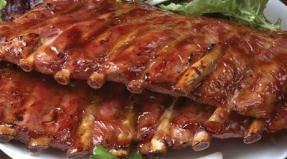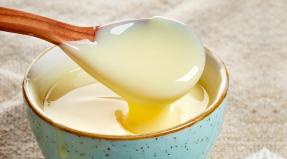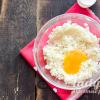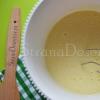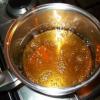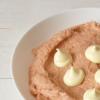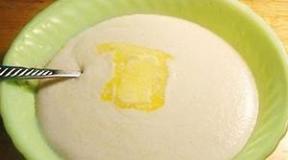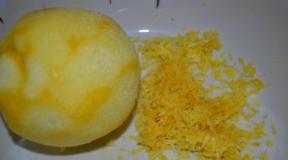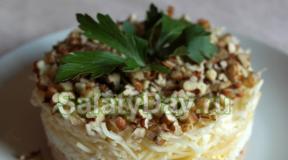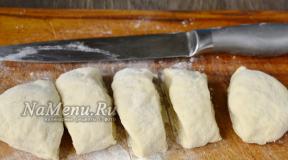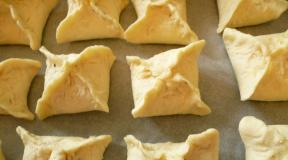How to prepare delicious croissants. Real Croissants at home
Secrets of the ideal croissant June 10th, 2015
Something was fascinated by the Switzerland (well, how can you not get carried away, yes?) And I completely forgot to tell you about our meeting with the secretary of Laurent Brecé, the director of the quality of the network of Baken "Volkonsky".
Literally a week before my trip in the Bakery Cafe-bakery "Volkonsky" at Sretenka, they arranged an incredible: Laurent Breusie himself personally shared with us the secrets of delicious croissants. Of course, who at least once in his life tried to make Croissants himself, will understand that it is not enough to know subtlety and secrets, a lot depends, of course, from experience. The perfect croissant is not easy. Real Croissant is akin to art. And, it turns out that the art of this was invented at all by the French. Surely many of you were surprised now, right?
So, ask questions, listen to the wizard. And at the end - we get a dough recipe from the maestro itself.
Not the French for the first time produced Croissant, they did not come up with him. But they brought him to perfection!
Then who? Who is the creator of this insanely air, crunchy, fragile, porous, melting the work of art?
Our main perpetrators of our ... (I'm sorry, I could not have kept, so it happened that if we had something to do something, Croissant is to blame for everything) - in fact, the Austrians. Official history of origin are several. But in both of all the Austrians are to blame. One version says that even during the Ottoman Empire period was known in the form of a month, allegedly at the time of the siege of Vienna, the Turks in the end, as a sign of victory, the Austrian bakers baked the product in the shape of a crescent. This is the ancestor of modern croissant. According to another version, in France, Croissant arrived from Austria: Monsieur Zang in the 19th century moved to Paris in the 19th century and opened his first bungeous, where the puffs, bagels and croissants were sold, prepared by his bakers using the technology with the addition of sugar and butter in the dough. By the way, Brioshi, another symbol of French cuisine, too, from Austria. What brought new French? They began to make croissants using yeast. The Austrians did not add them. A large amount of oil and yeast - that's what is distinguished by a real croissant from the ancestors of Rogan.
Monsieur Laurent cuts first Rogalik, and then the croissant and on the examples tells what they differ. And then carefully spins the croissant in the tape. What for? Only the right croissant can be so revealed, here it is the top of the skill!
And Laurent showed us a raspberry croissant, in which raspberries, squirrels, almond cream and sugar are used for the filling, they say it is very tasty, but I have not tried it yet. Authorship belongs to Lauren, and it seemed to even appear this croissant first in Volkonsky, and only later in France! This is how it happens;) next year, they promise something new, but so far they are not given the mystery.
Laying the tip of Croissant, a member of the Academy of Cooking France, the National Academy of Cooking, the International Club of the White Cap, the Associations of Eurocolpac and Eurogastronomy, and more many of some high-profile international associations (do not mention everything) remembered how one day "watched the terrible": Visitor "Volkonsky" Kushan drove with a knife and fork. Who is this "savage"? In general, it is even worse than drinking cappuccino in Italy for lunch. Do not bring you the Lord to make such a somewhere in Paris, it's all right, not every day Laurent is taking a Volkonsky. Nevertheless, he is busy: manages four dozen bakeries in Moscow, St. Petersburg, Nizhny and Kiev.
So we got to secrets.
Listen? Wrong? Ready to join the art?
1. Zam. Oxygen in the test is very important. But in this situation, the main thing is not to rearrange, it's not worth a lot of oxygen. Mix carefully, but do not overdo it.
2. Exquisites, yeast should be a bit, the principle - the dough must be approached slowly.
3. There is no difference, what yeast you use are dry or pressed. It is important that they work.
4. Temperature, ideal for kneading - 24 degrees, for rolling - 16, and for proof - 25-26.
5. When rolling it is important to change the direction of the test (rotate 90 degrees). It will make it plastic, it will be easier to succumb to each subsequent rolling (only 3 times you need to fold the dough and remove it in the cold).
6. At the stage of connection of the dough with oil, the dough ratio to the oil should be 250-300 g per 1 kg of test.
7. The dough and oil must be closely consistency: if the dough is too dense, and the oil is soft - it is a catastrophe. If the dough is soft, and the oil is dense, it is not a disaster, but also bad.
8. Oil should be at least 82.5% fat (more fatty we simply did not see, although someone said what happens), but ideally 84% or more.
9. Test thickness at the time of cutting triangles should be 2.5-3 mm. When minimizing them, they need to stretch slightly.
10. The longer the proceeding process, the better the taste.

And, of course, I would not be a Fudblerger if I had not scored a test recipe.
Strong flour 1000g
Biological yeast 30 - 40g
Salt 20g
Sugar 90-110g
Eggs (optional) 1pc.
Milk or milk + water about 6
Folding oil 450-600g
Alsystem
Weigh and ask for flour.
Add salt, sugar and almost all the milk or a mixture of milk and water (water should be taken a little less if the dough is rolled on the dough-saving machine).
Next, add yeast divorced in a small amount of water.
How to knead the dough so that the mass is elastic and elastic. The dough should be easily lagging behind the battles of the container in which it is kneaded.
First lift dough
Depending on the time of the year, start making the first kneading at room temperature for about 30 minutes.
Note: Cover the dough with a towel so that the crust does not form.
Then stop the dough into the refrigerator (+5 ̊c) and leave it there until the next day.
If you want to use the dough on the same day, leave it to parted for 1 hour, then place it in the refrigerator for several minutes in order to alleviate folding.
Folding
Roll the dough as a rectangle with a thickness of approximately 1 cm.
Separate the oil on the half of the dough rolled in the form of a rectangle.
Cover half of the rectangle, which lies the oil, the second half. Align and "seal" the edges using a rill.
Collapse in three layers or twice in half.
SHAPING
After the proofing within a few minutes, roll out the dough into the form of a rectangle with a length of 32 cm and a thickness of approximately 3 mm.
Note: Sometimes it is necessary to cut the dough into two parts.
Cut the rectangle into two strips of 16 cm wide.
To impose one lane to another, pre-speaking them with flour.
Cut triangles with a base of 12 cm weighing about 40-50g.
Turn the triangle starting from its base, not too pressing at the same time. Work with two palms, while stretching the dough slightly in the opposite sides.
7. You can cut a triangle base with a knife to facilitate coagulation.
Place croissants in the shape of a crescent on a moisture opponent: 20 pieces on the contrary size of 60x40. Put the croissants in the tips down.
Moderately lubricate croissants with melange.
Second lifting test
Put a touch in a frost cabinet (35 - 40 ̊С).
Before croissants finally rummage, remove them from the proof to give them the opportunity to "gain strength".
Lubricate croissants with melange again.
BAKERY PRODUCTS
Set the temperature of the oven by 250 ° C. Bake for about 12 minutes. Open the door of the furnace at the end of the baking.
Wow! There is a serious work!
Did not change my mind to try?
Brought Croissants home. I love them with greens and Parm ham for lunch or late breakfast. Nourishing and tasty snack is obtained.
And we treated us and told a little about baguettes.
- 2½ cups (190 g) flour;
- 150 g of butter;
- 120 ml of milk;
- 45 g of sugar;
- 25 g of fresh yeast;
- a pinch of salt.
Start by kneading the yeast base. Heat the milk, making sure that it is not so hot to kill the yeast, but warm enough to activate them. Dissolve in hot sugar milk and frow fresh yeast. Leave the mixture warm at the time of cooking the second part of the test.

Mix the sifted flour with a pinch of salt and add pieces of icy oil to it. With the help of a knife or blender, turn everything into the crumb.

Pour the yeast solution to the crumb of flour and oil, mix everything with a spoon. Try to minimize the touch of the dough with your hands so that the pieces of oil do not melted.

Form the finished dough into a rectangular brick, wrap the film and leave in the fridge for half an hour.

Now the most time-consuming is rolling. Roll the dough into a rectangular layer.

Fold the layer along half.

Then - once again in half, but already across. Fold the dough as shown in the photo to get a piece of initial size.

Roll the dough again and repeat the procedure three times. First, the dough will be a mercury, but as folding-folding, with the help of a drop of patience and a small amount of flour, it will become very fitful and smooth.
All major manipulations are over. Now it remains only to wait. Wrap the dough with a film and remove into the fridge for a couple of hours or all night. Such a blank can also be frozen.

After the dough, 25 × 40 cm is rolled into a rectangle and divide on 8 triangles.

Each of the triangles now remains to roll into the roll, moving from the base to the top, lay out on the baking sheet, lubricate the egg yolk (or its mixture with milk) and send to be baked: 8 minutes at 220 degrees, and then 12-15 minutes at 180 degrees.

These simple croissants are obtained very soft and layer. If desired, at the stage of folding the test, you can add a jam or chocolate filling.

Step 1: We begin the test of the test.
First you need to sink flour through fine sieve into a shallow bowl to saturate it with oxygen, then collect her by a hormster, and in his center make a depression. In another dish, open the yeast, spread them with 2-3 tablespoons of warm water. Pour the yeast solution into the well in the flour, mix well with quarter from the whole mass of flour And roll from her the ball.Step 2: Mix the dough.
 Cooked with a cooked cross, then put in a large bowl with warm water. Mix the remaining flour with sugar, salt and halves from the required mass of butter. Then add milk and sweat the dough carefully, to a homogeneous elastic consistency. Cutting the cutting board well to flour and continue to wash the dough on it until it becomes an elastic and smooth texture.
Cooked with a cooked cross, then put in a large bowl with warm water. Mix the remaining flour with sugar, salt and halves from the required mass of butter. Then add milk and sweat the dough carefully, to a homogeneous elastic consistency. Cutting the cutting board well to flour and continue to wash the dough on it until it becomes an elastic and smooth texture. Step 3: insist the dough.
 As soon as the ball from the dough will rise and increase, approximately twice, remove it and sound well can be used a paper towel. Now thoroughly mix it with the rest of the test. Mix the dough until homogeneous mass. Sprinkle with flour and place the mixed mass into it. Close the lid and put a saucepan in the cool place, preferably all night.
As soon as the ball from the dough will rise and increase, approximately twice, remove it and sound well can be used a paper towel. Now thoroughly mix it with the rest of the test. Mix the dough until homogeneous mass. Sprinkle with flour and place the mixed mass into it. Close the lid and put a saucepan in the cool place, preferably all night.
Step 4: Roll over the dough.
 The working surface of the table Sprinkle a slightly additional flour and roll it into a rectangle. Now try to divide the vertically (mentally) rectangle into three equal parts. The central part lubricate the thin layer remaining the creamy oil.
The working surface of the table Sprinkle a slightly additional flour and roll it into a rectangle. Now try to divide the vertically (mentally) rectangle into three equal parts. The central part lubricate the thin layer remaining the creamy oil. Step 5: fold the dough.
 Now the central part of the dough with butter, cover the right third, and in the top of it to put the left part. Folded the dough turn over 90 degrees, roll it up in a vertical position, from the side of open edges. Then repeat the same actions and put the dough in the refrigerator, about 15-20 minutes. Repeat 3 more times.
Now the central part of the dough with butter, cover the right third, and in the top of it to put the left part. Folded the dough turn over 90 degrees, roll it up in a vertical position, from the side of open edges. Then repeat the same actions and put the dough in the refrigerator, about 15-20 minutes. Repeat 3 more times.
Step 6: Cutting the test.
 Now you need to roll out the dough into a rectangle, a thickness of no more than 3 mm. Cut the dough along 3 identical stripes, to cut each strip diagonally, so that triangles are. Triangles must be started from a wide end, and then roll into the rogoli and roll a little to get the shape of the crescent or honeycomb. Spread the croissants tray, slightly powdered with flour, and bake at 220 degrees in the oven until complete readiness.
Now you need to roll out the dough into a rectangle, a thickness of no more than 3 mm. Cut the dough along 3 identical stripes, to cut each strip diagonally, so that triangles are. Triangles must be started from a wide end, and then roll into the rogoli and roll a little to get the shape of the crescent or honeycomb. Spread the croissants tray, slightly powdered with flour, and bake at 220 degrees in the oven until complete readiness. Step 7: Let's give the dough for croissants.
 During the baking, the croissants should increase in volume, and acquire a golden color. Then slightly cool the finished croissants and put them on the dish. Serve such a delicacy is best for tea for breakfast. Enjoy your meal!
During the baking, the croissants should increase in volume, and acquire a golden color. Then slightly cool the finished croissants and put them on the dish. Serve such a delicacy is best for tea for breakfast. Enjoy your meal! Trying to roll only in one direction, so as not to spoil its puff structure.
For the preparation of the test, be sure to use only the freshest and high-quality products. Especially follow the production of butter and milk.
For croissants, it is possible to prepare a freezing puff pastry, but still better and tastier dough yeast.
- 2½ cups (190 g) flour;
- 150 g of butter;
- 120 ml of milk;
- 45 g of sugar;
- 25 g of fresh yeast;
- a pinch of salt.
Start by kneading the yeast base. Heat the milk, making sure that it is not so hot to kill the yeast, but warm enough to activate them. Dissolve in hot sugar milk and frow fresh yeast. Leave the mixture warm at the time of cooking the second part of the test.

Mix the sifted flour with a pinch of salt and add pieces of icy oil to it. With the help of a knife or blender, turn everything into the crumb.

Pour the yeast solution to the crumb of flour and oil, mix everything with a spoon. Try to minimize the touch of the dough with your hands so that the pieces of oil do not melted.

Form the finished dough into a rectangular brick, wrap the film and leave in the fridge for half an hour.

Now the most time-consuming is rolling. Roll the dough into a rectangular layer.

Fold the layer along half.

Then - once again in half, but already across. Fold the dough as shown in the photo to get a piece of initial size.

Roll the dough again and repeat the procedure three times. First, the dough will be a mercury, but as folding-folding, with the help of a drop of patience and a small amount of flour, it will become very fitful and smooth.
All major manipulations are over. Now it remains only to wait. Wrap the dough with a film and remove into the fridge for a couple of hours or all night. Such a blank can also be frozen.

After the dough, 25 × 40 cm is rolled into a rectangle and divide on 8 triangles.

Each of the triangles now remains to roll into the roll, moving from the base to the top, lay out on the baking sheet, lubricate the egg yolk (or its mixture with milk) and send to be baked: 8 minutes at 220 degrees, and then 12-15 minutes at 180 degrees.

These simple croissants are obtained very soft and layer. If desired, at the stage of folding the test, you can add a jam or chocolate filling.

Fresh home croissants for breakfast - troublesome history, and to spend an early morning at the slab agrees. According to experienced hostesses: the dough for croissants is prepared in advance, ergonomically cut the rolled reservoir and form blanks in a matter of minutes. Very soon, ruddy bagels are collected at the table of the most revealed Leisebeck.
Classic croissants bake out of puff yeast dough. Starting in them is usually not put. The French prefer to enjoy the skill of the baker, so the taste of the test, the composition and its structure is so important.
Ingredients:
- 300 g of flour;
- 100 ml of milk;
- 40 g of sugar;
- 10 g dry yeast;
- 5 g salts.
It is worth in advance to distribute the stages of working with the test, carefully calculate the time.
If baking is scheduled for a Sunday breakfast, you need to start training from Friday.
Friday evening - kneading dough and oil.
Working with dough:
- In the sifted flour, lay out all the ingredients.
- It is very quick to produce the dough that the dough is not delayed.
- Wrap hermetically in the film.
- The dough ripens half an hour indoors and 6 to 8 hours in the refrigerator.
Oil is prepared separately.
- Chilled oil (200 g) chop the knife.
- The table is slightly up with flour. Oil absorbs it, so use no more than 50 g.
- Easy to soft, without allowing oil to fit.
- Roll into a small rectangle.
- Cool, wrapped in the film.
Saturday: Preparation of the test in four approaches with an interval of 2 hours.
- Roll out dough on parchment.
- Share on it the oil plate.
- Break the edges of the mustache.
- Stinks to distribute oil in an envelope from the test.
- Several times put it with a rolling pin in one direction.
- To cover the second sheet of parchment and remove in cold for 2 hours.
- Cut the envelope four times from the test, roll and remove to the cold.
- Roll the layer with a thickness of 5 - 6 mm, cling to the food film and roll into the roll.
- Remove the workpiece in the package and in the refrigerator.
Sunday: Formation of bagels, proofing and baking.
- Cut cold dough.
- Share fillings.
- Shape billets.
- Leave for proofing in a warm place for an hour.
- Lubricate yolk.
- Bake at 180 ºС 15 - 20 minutes.
Fast cooking recipe
You can prepare the dough on yeast, it is much easier, although it will not correspond to the canons of French bakeries.

Ingredients:
- 200 g of flour;
- 150 g of butter;
- 120 g of milk;
- 40 g of sugar;
- 10 g high-speed dry yeast;
- 5 g salts.
Stages of work:
- Mix flour with yeast, salt and sugar.
- Stay in it frozen oil and chop the knife into the crumb.
- Pour milk.
- Quickly knead the dough so that the oil is not melted.
- Half an hour to hold the resulting composition in the cold.
- Roll out the cold base into the reservoir. Roll in half, roll out.
- Collapse in another direction and roll out again.
- Repeat three times fold in each direction. By the need to make flour.
- Hold the dough layer in the cold in the film about 6 hours.
- Roll, cut and roll croissants.
- Bake such a dough is necessary for 8 minutes at 220 ºС and another 12 minutes at 180 ºС.
Puffwindless dough for croissants
Croissants are much faster from the puff rootless dough. This basis does not need to parted for hours.



Ingredients:
- 400 g of flour;
- 200 ml of water;
- two eggs;
- 20 ml of strong alcohol;
- 40 ml of vinegar;
- 2 - 3 g of salts.
So that the oil does not melted in their hands, and the dough came elastic, it should be cold in the room - 16 ºС.
In the old days, the French bakers were preparing the dough in the early morning, while the kitchen is not yet fed. They had to knead the perfect foundation without the help of modern mixers and combines.
- Mix the liquid ingredients and pour them into a sifted flour.
- Quickly knead the dough, wrap in a film and remove to the cold.
- 200 g of cold butter can be kneaded with two spoons of flour.
- Roll out a thick cake from it, wrap in a film, and cool together with the test.
- Roll the blank in the same way as yeast puff pastry, but with intervals for cooling only 30 minutes.
- Ready layer cut into portions and minimize them with traditional crescent bays.
- Bake at 220 ºС 20 minutes.
Curd-based basis
Gentle-cream baking from cottage cheese dough does not need fillings, but you can add it to some sweet jam.

Ingredients:
- 320 g of flour;
- 80 g of butter;
- 200 g of fat curd;
- 100 g of sugar;
- egg;
- 100 g of sour cream or natural yogurt;
- 10 g soda;
- vanilla extract.
Working with this test will require several times less than with puff.
- Cottage cheese to carefully kill a blender or wipe through the sieve so that there are no dense lumps.
- Add the remaining ingredients to it, the flour must be sifted.
- Half an hour dough ripen in the refrigerator under the film.
- Roll out the layer with a thickness of 6 - 7 mm.
- Cut it, roll croissants.
- Bake at 180 ºС, watching the formation of a crust.
How to wrap croissants from puff pastry

- Puff pastry is most often rolled in the form of a rectangle. The reservoir is divided into small pieces of size, approximately 25 * 10 centimeters, and each is cut diagonally.
- The dough rolled out by a long strip is divided into high triangles of one zigzag line.
- Curd dough can be rolled out in the form of a circle and then cut it into portion triangles even easier. The circle is divided into 8 equal wedges with four cuts in diameter. From the obtained high triangles, rolls twist, ranging from a wide base and ending with a sharp angle. At the base of the workpiece make a small incision to make it easier to turn the roll. Croissant's edges slightly tightened to each other, giving him the shape of the crescent.
The bun with such a special curved form received its name. The interesting legend of the Epoch of Ottoman Wars in Europe is connected with this.
During the time of the two-month siege of Vienna, the Turks tried to take a dust and penetrate the city wall. Bowls, rising in the middle of the night to prepare morning bread, warned urban custody about suspicious noise and raised the plans of Ottoman conquerors. On this occasion, the first rogoli in the form of a crescent (WIENER KIPFERL (HIM) was baked. For a long time, their preparation was a purely Vienna tradition.
Only after a hundred years of Maria-Antoinette, the daughter of the Austrian emperor, brought a favorite recipe for a new homeland. Already here, in France, Croissant received his name (Croissant (Fr.) - Crescent) and turned into an air puff delicacy.
Most Popular Croissant Fillings
Stuffing is laid out on a wide part of the triangle. The product is folded, not to protinate the edges.



If the croissants bake without fillings, a small piece of dough is wrapped in the base of the triangle to give the product volume.
Cook traditional morning buns both with sweet fillings and snacks.
Dessert croissant Start:
- chocolate;
- chocolate sweet with milk, cream oil and a spoon of cognac;
- various jams and jams;
- fresh fruits or berries;
- boiled condensed milk;
- marmalade;
- dried fruits and nuts;
- marzipan;
- cottage cheese.
Lovers of diet breakfast prefer:
- ham and solid cheese;
- chees Feta;
- pieces of game or rabbit;
- smoked chest and other meat delicacies;
- a variety of vegetables, possibly with mushrooms;
- fish and seafood.
The snack filling is sometimes embedded in the finished croissant, cutting it in half.
From above, a bun is watered with all sorts of sauces, according to the filling.
In any case, the success of breakfast depends on the quality of puff baking, its pomp and fragrance.

